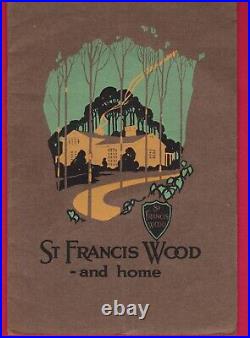
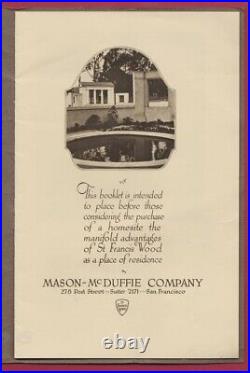
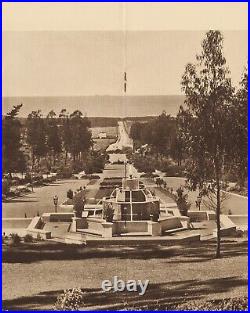
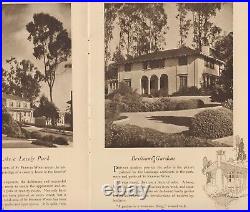
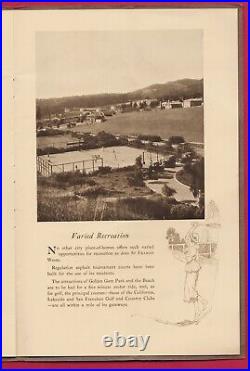

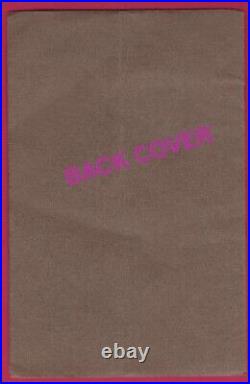

Upscale master-planned residence park; homesite promotion booklet. 16 stapled unnumbered pages with text and 16. Photographic pictures of residences and surrounding property. Measures 10 by 8-1/2 inches. DATE: The text mentions, The St. Francis Fountain, recalling those of the Panama-Pacific Exposition, were planned by Henry H. Gutterson, making the date. Yet this booklet appears to be early in its development. Slight, hardly noticeable, vertical crease to center of pamphlet. [or other wording] in. May have been super-imposed over the images for security or informational reasons and are not on the actual item. Is one of eight master-planned RESIDENCE PARKS. Southwestern San Francisco, California, south of the West Portal neighborhood and west of Mount Davidson. Characterized by family homes on spacious lots (by San Francisco standards), St. Francis Wood has no visible businesses and has a correspondingly low profile compared to similar wealthy neighborhoods such as the Marina District and Pacific Heights. Francis Wood is one of. John Galen Howard, Professor of Architecture at the University of California, designed the pavilions and walled gardens that mark its main gateway. After the resolution of Adolph Sutro’s will in the early 1910s, the Residential Development Company bought from his estate 725 acres of the old Mexican land grant, the Rancho San Miguel. On heavily-forested land remote from downtown San Francisco, the Mason-McDuffie Company sought to create a residence park that embodied the highest ideals of early twentieth century landscaping and architecture. The “City Beautiful” movement, popularized by heralded landscape architect and planner Daniel Burnham, influenced the community plan. Landscape features meant to be “reminiscent of the loveliest gardens of the Italian Renaissance” ornamented the grounds, including an elaborate gateway and two fountains on the main arterial, St. The famed landscape firm Olmsted Brothers laid out the curvilinear street plan. John Galen Howard acted as the first supervising architect, designing the elaborate lampposts, brick-diamond sidewalks, entryway pillars, and the main gate and first fountain. Henry Gutterson soon succeeded Howard and designed the monumental upper fountain and numerous houses over the next three decades. McDuffie launched the sale of. The streets were paved with curbs and sidewalks; all utilities such as electricity, sewer, water, telephones and gas were promised to be installed by March 1913. In his advertising, McDuffie made much of the fact that utilities were to be placed underground. The idea of underground electricity and telephone lines was new at the time. McDuffie did not open the entire tract for sale at once. He improved the property and offered lots in phases. The initial offering consisted of 283 lots in the “horseshoe” section with St. Francis Boulevard forming the spine. Mason-McDuffie’s business plan was to offer lots for sale in a residential park, but not to design or build the actual houses. Buyers were free to choose their own architect. Mason-McDuffie ultimately built a number of homes of speculation to sell to customers as well. The San Francisco Residence Parks. Are located in the western neighborhoods of San Francisco. The first of the master-planned residence parks to be built on the West side of the city was. This was followed by. Sea Cliff, Lincoln Manor, West Clay Park, Forest Hill, Balboa Terrace, Ingleside Terraces, and Jordan Park. In San Francisco were landscaped plots created to replicate the feeling of suburban living in close proximity to downtown San Francisco. Inspired by lofty ideals of the City Beautiful and Garden City movements, residence parks had curving boulevards and lush landscaping -trees, greens, and neoclassical ornamentation such as pillars, gateways, public stairways, and sundials. San Francisco’s residence parks all had significant restrictions, including prohibitions on commercial activity, yard size, minimum construction costs, and, initially, racial covenants. Sales increased significantly in the 1920s, and by the 1930s most tracts in San Francisco residence parks were already constructed. From the estate of an early. UI – B2 – S4. (code to locate the item).

